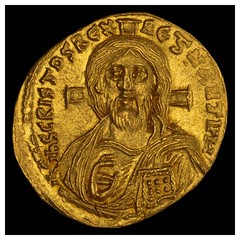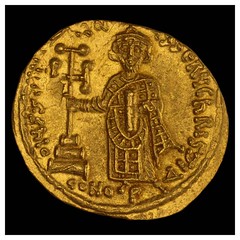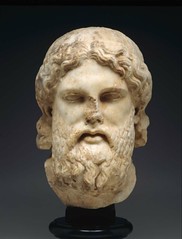
PREV ARTICLE
NEXT ARTICLE
FULL ISSUE
PREV FULL ISSUE
MORE ON COINS WITH AN IMAGE OF JESUS
Regarding the recent article about a coin at Princeton University featuring an image of Jesus Christ,
John Nebel writes, "See what you started with an article in The E-Sylum!" Below is an exchange he had with Kent Hughes, a roommate of his back at Princeton University.
-Editor
Justinian II summoned a Ecumenical Council in 692 in Trullo whose Decrees and Canons were never signed by Sergius, the Pope. Justinian went so far as to attempt kidnapping Sergius to obtain his signature, nevertheless, Justinian proceeded as if they were in effect. Canon LXXXII states in part "In order therefore that 'that which is perfect' may be delineated to the eyes of all, at least in coloured expression, we decree that the figure in human form of the Lamb who taketh away the sin of the world, Christ our God, be henceforth exhibited in images, instead of the ancient lamb, so that all may understand by means of it the depths of the humiliation of the Word of God, and that we may recall to our memory his conversation in the flesh, his passion and salutary death, and his redemption which was wrought for the whole world." The ancient Epitome is succinct: "Thou shalt not paint a lamb for the type of Christ, but himself." As a result, Justinian's coinage is the first Byzantine coinage to portray Christ. I've attached images of this coin, Christ is on the obverse, Justinian on the reverse. The December 6, 2009 E-Sylum (v12n49) had inspired me to look into the coin and I found one in an auction in Frankfurt.


A 1959 monograph by James Breckenridge, "The Numismatic Iconography of Justinian II" in Numismatic Notes and Monographs, New York, American Numismatic Society, draws the startling conclusion that the portrait of Christ is derived from a statue of Zeus at Olympia by the Greek sculptor Phidias, one of the Seven Wonders of the Ancient World. This image appears to have become one of the traditional images of Christ. en.wikipedia.org/wiki/File:Christus_Ravenna_Mosaic.jpg
I've thought the last several years that one cannot underestimate Plato's influence on Christianity, however, I hadn't realized the extent of the ancient Greek iconographic influence until recently, although this coin of Philip II had me wondering a few years back: www.ancientmoney.org/greek_kingdoms/philipii_tetradrachm.html
To read the earlier E-Sylum article, see:
PRINCETON ACQUIRES 7TH CENTURY COIN WITH AN IMAGE OF JESUS
(www.coinbooks.org/esylum_v12n49a15.html)
The Numismatic Bibliomania Society is a non-profit organization promoting numismatic literature. See our web site at coinbooks.org. To submit items for publication in The E-Sylum, write to the Editor at this address: whomren@gmail.com To subscribe go to: https://my.binhost.com/lists/listinfo/esylum All Rights Reserved. NBS Home Page Contact the NBS webmaster 
|
